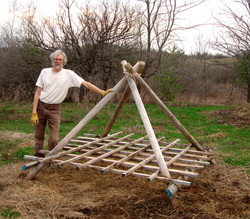 As some of you know, I have had to move off my farm. A long, dark, and bitter story, that I will save for another time. This is the last and final thing that I moved off my farm yesterday. My friends and family think I was nuts to go back and get it, but it's my favorite "invention" from my farm. ("Invention" like in re-inventing the wheel. Haystack frames have been around for a long time, of course.) It was the latest and most successful evolvement of my Pyramid Haystack frames. It was in continues use for over 5 years, and left outside the entire time. All the wood and ropes are still completely sound. I hope to use it again somewhere this summer, and for many to come. When I first started out in 2001, with my Scythe Supply scythe and The Scythe Book, I was excited about experimenting with the haystacks that I read about in the book and on Scythe Supply's website. To my dismay, every hay drying rack and stacking method that I tried, turned into compost on a stick. I called Elliot Fishbein for a consultation, but he was baffled by my results. After several years of experimenting, I finally developed a system that worked for me, here on my farm in Wisconsin. I called it the Pyramid Haystack, and I emailed Scythe Supply about it. Sadly Elliot was no longer with us by then, but Carol was very excited about it and asked to post my email on her website. See http://www.scythesupply.com/workshops/hayRackWorkshop.htm Well, that was a long time ago now, and my haystack has evolved quite a bit since then. I wrote about it in my 2010 blog post entitled Haystacks, but I didn't get around to posting the latest updated photos of the beefed-up version of my pyramid haystack frame. Once I got my goose house built, I didn't need the haystacks to be so portable, and I wanted to be able to leave them in place for many years. I am also 6'5" tall, and I can really pile the hay very high, making for a very heavy structural load. Over the years I had a couple of 2x4 uprights break at structural weak points (big knots), as the hay settled. So I switched to cedar fenceposts for the uprights. They were stronger and more weather resistant. To keep the feet from sinking in the clay mud, as well as to prevent rotting, I placed them on flat paving stones. I had problems with rabbits chewing through natural ropes, and with the sun deteriorating cheap artificial fiber ropes, so I switched to UV resistant rope, plus wrapped some extra rope around the top, just in case a rabbit got up there. Chain might be a good idea, in the future. Rabbits love these haystacks in winter. Warm and cozy, a roof over head, and plenty to eat. (Best tasting rabbit I've ever had, though, and I don't mean for revenge's sake. I mean they really are good tasting rabbit meat. Wild rabbits on an organic farm, that over-winter on organic red clover hay and wild browse, taste a whole lot better than rabbits raised in cages on rabbit chow!) To discourage rabbits and mice from taking up long-term residence and getting too comfortable, I like to have the platform raised high enough off the ground for my dogs and cats to get underneath it. In the winter, the haystacks are always the first place the dogs want to run to, when they are let out in the morning. In addition to giving the dogs access, the raised platform truly allows for plenty of air to circulate underneath the stack. Unlike most other haystacks, the best hay in these stacks is on the bottom. Another reason that I wanted to experiment with "beefing" up my haystack frame, is because people who winter their cattle outdoors, have asked me if my haystack could be used to let the cattle eat the hay out of them directly. That way they could be placed scattered throughout a summer hayfield, and as the cows ate down each haystack in the winter and moved on to the next, their winter manure would be more distrubuted over a greater area, instead of an entire winter's worth concentrated up by the barn (and with them continually standing in it!). Since I don't have cows (nor sheep), I haven't been able to test this. Traditional haystacks that are piled very high, like the Romanian-style haystack, are dangerous when eaten from the bottom, because then they can tip and collapse, and smother or injure an animal. I think that my pyramid haystack would be safe in this regard. They are low, wide and stable. However, I don't think the 1x2's and 2x2's would survive being trampled by cows. If someone wanted to try this, I think the best approach would be to keep the haystack fenced off, until you want to let the animals eat it. Then when you let them have access to it, help them out by pulling some of the hay from the top, and spreading it around every day when possible, and when it gets down near the bottom, pull out the hay and remove the frame from the area, so they can't hurt themselves with it. When all the hay is all cleaned up, let them have access to the next one. I once had criticism that my haystack frame requires a lot of expensive, store-bought, dimensional lumber. Other than the cedar fenceposts, I mostly used leftover and salvaged lumber. I bet for many of you, the common easy access to these materials is appealing. However, if you happen to have some woods that needs thinning, and a Silky saw, this haystack frame could easily be made out of saplings and young trees. 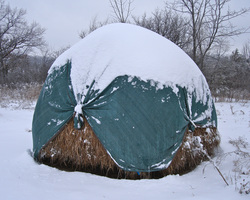 The success of these pyramid haystacks is completely dependent on what covers it. The 12'x12' yard tarps that I used to be able to buy at my local farm supply store, worked very well. They cinched down snuggly and conformed to the shape of the stack. They stayed put in most winds, yet were easy to put on and and take off. When these tarps were no longer available, I switched to using two 10'x14' rectangular tarps, crossed over the top, and tied down at the four corners. This gave good coverage from rain and snow, but the tarp flapped incessantly in the wind, and this wore them out much quicker. So I started bunching up excessively loose parts and tying them off with string. This cut down on the flapping, but made it more inconvenient to access the hay. I am still searching for a better material to cover these stacks. For more info see Pyramid Haystack Update 2
3 Comments
Karen Pusin
11/19/2013 11:29:24 pm
Thanks for this. I am planting more this fall to make hay in the spring and this answered many concerns about haystack building. My Jack Russell said you are so right about the wild rabbits too...
Reply
earl sluder
11/22/2013 04:59:59 pm
to alow cattle yo eat directly from the haystack you could make a haystack ring that would be simular to the round bail ring that farmers put the large round haybailes in when they feed cattle.i would make it in sections so that it would be easy to put around the haystack an you would be able to adjust the ring to the size of the haystack.
Reply
Joanne Vaughnva
6/15/2014 01:37:11 am
This update is going to be very helpful. We are going to try this for 2014 in western NY. We will try to feed sheep directly from these stacks. Any suggestions?
Reply
Your comment will be posted after it is approved.
Leave a Reply. |
Botan AndersonArchives
March 2023
Categories
All
|
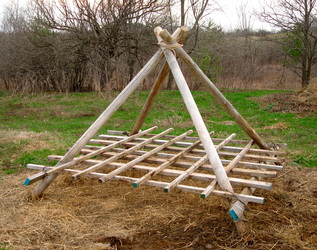

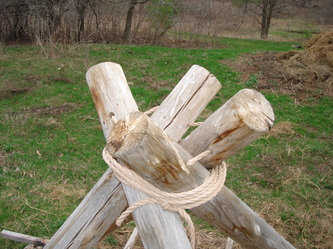
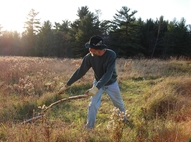
 RSS Feed
RSS Feed